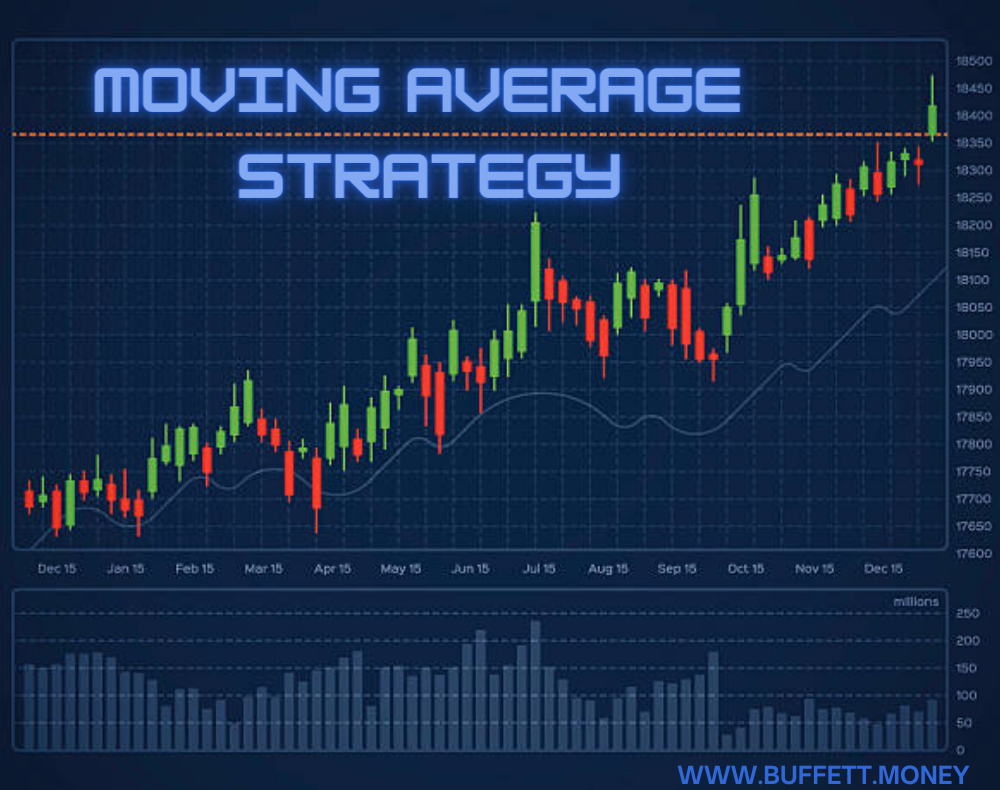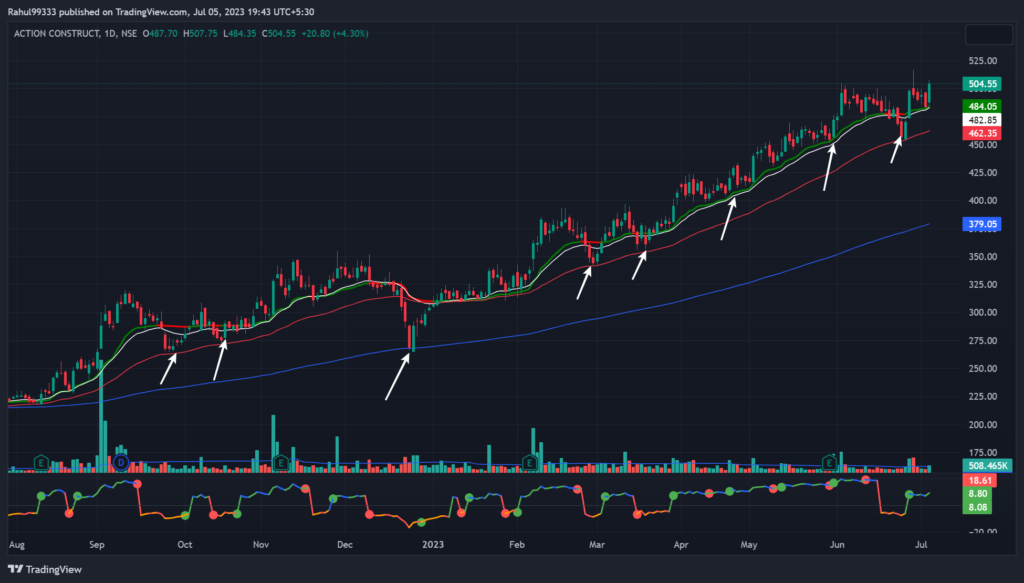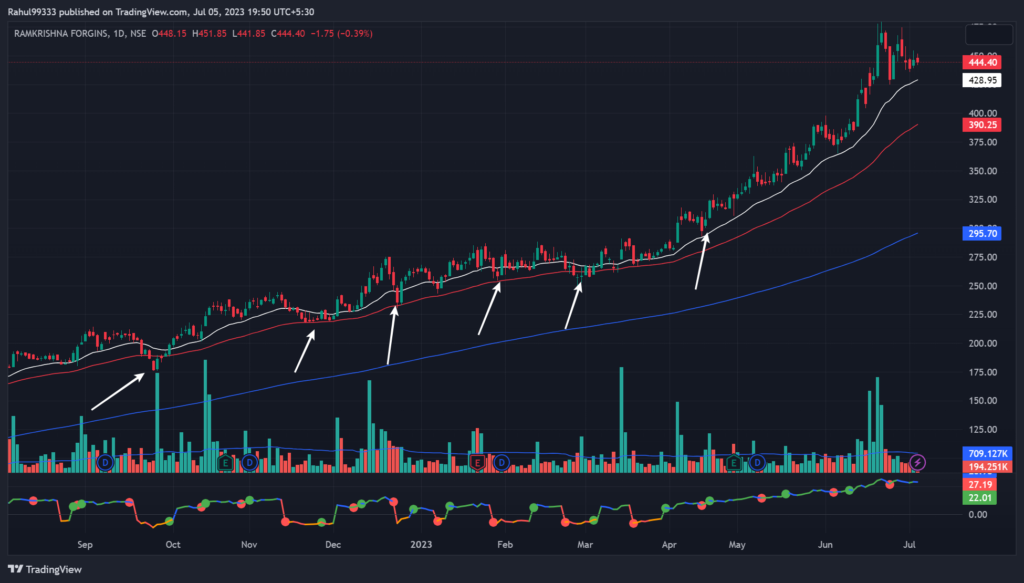
Moving averages are a commonly used technical analysis tool in trading. They help smooth out price data, making it easier to identify trends and potential entry or exit points. A moving average is calculated by taking the average price of an asset over a specific time period and updating it as new data becomes available. Today we will learn types of Moving Averages and a Moving Average Strategy.
There are several types of moving averages, including:
1. Simple Moving Average (SMA): The SMA calculates the average price of an asset over a specified number of periods. Each data point is given equal weight in the calculation.
2. Exponential Moving Average (EMA): The EMA assigns greater weight to more recent price data, resulting in a faster response to recent price changes compared to the SMA.
3. Weighted Moving Average (WMA): The WMA assigns different weights to the price data, with more recent prices usually given higher weights.
Moving Average Strategy :
When a stock starts performing and goes in Uptrend then many times it gives opportunities at pullback on key moving averages. So, when it comes to pullback we have to use it at proper levels for best risk reward ratio. Let’s learn the set up completely with proper entry, exit and how to pick that stocks step by step. In last we will have a pro tip also.
Create watchlist :
Before we apply the strategy we should have a proper watchlist of the stocks on which we will apply our moving average strategy. In that watchlist we should have stocks that are in proper uptrend and giving good rally. Stocks should be trading above all important moving averages (20, 50 & 200). These stocks should be fundamentally sound and recent quarter results should be good and above estimates.
Market Trend :
The best time to apply this strategy is then when General Market Trend is in Uptrend. In the trending market 75% of the share performs and chances of your success are high. Especially if you have experience of less than 3 years then you should not trade this strategy in the downtrend and Neutral trend.
Entry :
In this strategy entry should be taken when stock after a move with good volumes retrace back to key moving average. If the stock is moving slowly up then we should use 50 Day Moving Average. When stock shows some correction and available on 50-DEMA with low volumes then we can use 50-DEMA as support and attempt a buying.
For safer investing we can also use 200 Day Moving Average as a support. We can also use 20 Day Moving Average in exceptional situations only (like stock has moved more than 15% in a month). Also this is a bit risky so low patient and low risky traders should not use it without a bit of experience and back testing.
Entry should be made when stock is taking support on Moving Average or bouncing from the support within the range of 2%-3% of the key Moving Average.
Target :
In this strategy if the market trend is in Uptrend and you have picked a good stock then you can easily put the target of 10%-15%. And if your target is achieved and stock is still showing strength then you can book half the quantity and trail rest below 10 Day Moving Average. If not showing strength after target then you can also book all as per your risk profile.
Stop Loss :
Stop Loss is an insurance for a trader to safeguard the capital from big loss. You should not become emotional and take it if it is hitting. Stop Loss should be 3% below the Moving Average on which you are taking entry. Don’t increase your stop loss if stock is going down. Always trail if stock shows some movement in your desired direction so that you will not lose any part of your capital.
Exit :
First exit is very simple that when your stock hits the target or Stop Loss you can exit from the stock. Other than this if you found any weakness in stock due to any news or event then you can exit from stock without hitting the Target or Stop Loss to stay away from volatility of stock. Also if the market shows some signs of weakness and your stock is a trend follower then also you can make decisions accordingly.
Position sizing :
Position sizing here means how much you should invest in a particular stock or strategy. So, for that we should never invest more than 10% of our capital in any single stock. Also don’t invest more than 25% of your portfolio in a single strategy. You should keep in mind that you will not lose more than 0.5%-1.0% of your capital in one trade.
Examples :


Conclusion :
So, finally if we come to conclude our Moving Average Strategy then we should always use it after learning it properly and also back testing it. Without being backtest the strategy doesn’t invest large amounts in any stock or trade. If you are a beginner and just started the stock market journey then you should learn the strategy properly and trade with very small amounts and have conviction on strategy in your own way.
The strategy shared above is just our experience and a method which we use personally. There is no such thing as a 100% success ratio. The strategy can fail and your stop loss can hit. We shared it just for educational purpose. Consult your financial advisor before investing or do your own research and analysis before applying the stock.
Also don’t get confused with EMA or SMA use. In 20 & 50 Day Moving Average both will be almost same. But 200 Day Moving Average can have some difference. We personally use EMA because it shows the latest data. Also remember that all charts will not as clear as shown above so use it properly.
Pro Tip :
If any stock breaks 50 or 200 Day Moving Average after a clean rally for the first time then you should wait for entry when it reclaim that Moving Average. If it reclaim and closes within the range of 1% above from that Moving Average then that stock have potential to give returns immediately.
Learn More :
Thank you for reading Buffett Money’s guide on the Moving Average strategy. To keep learning and developing your knowledge of financial analysis, we highly recommend the additional resources below:
- Penny Stock
- High Growth Stocks
- Dividend Yield Stocks
- False Breakout Stocks
- Fundamentally strong stocks
- AI impact on Algo Trading
- 5 Best Stocks
- Averaging Down Strategy
- Methods of Stock Market Prediction
- 5 Best Stocks for July
Thank You
Happy Investing





Pingback: Advantages and Disadvantages of Options Trading ! -